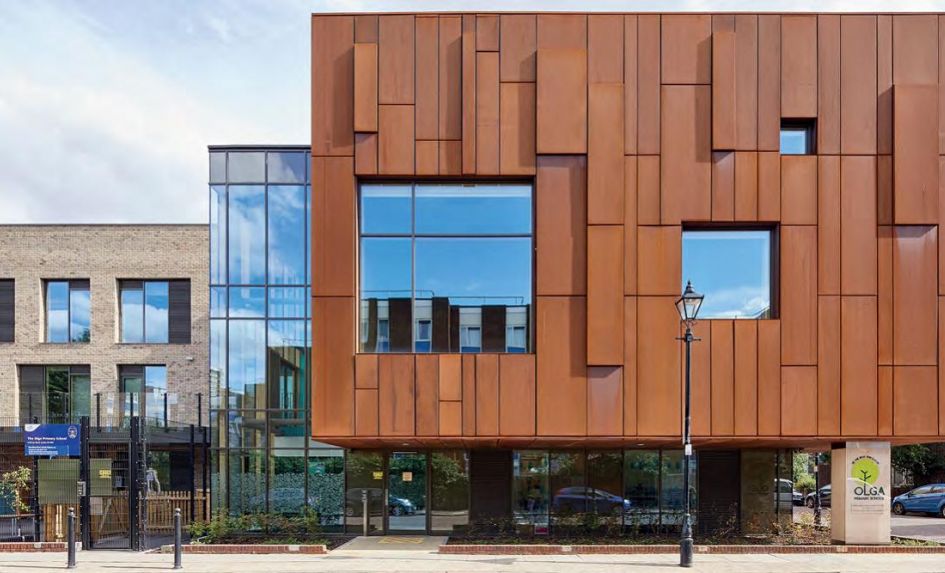As Lee Mainwaring, design director at the firm Architecture Initiative tells it, everything began in 2012 with an approach from Tower Hamlets Council and a PFI provider, who talked of ‘A challenging site for you guys.’
The site in question was that occupied by Olga Primary School, at that time a single-form primary with 240 places, housed in premises that consisted of a sprawling, 80s-era single-storey building. Hasib Hikmat, Olga’s current SBM, recalls, ”The building’s internal space was largely open plan, and not particularly well liked. Partitions had to added to create separate classrooms – it was very noisy.”
Initially, the Council’s brief seemed rather modest – two classroom extensions to help the school accommodate a projected rise in pupil numbers over the coming years – but as the project progressed, the plans soon became much more ambitious.
Use of space
The Council’s original ‘two extensions’ plan had been prompted by the perceived difficulties involved in working on the school site, described by Mainwaring as “This little green oasis in Tower Hamlets.” Yet over the course of discussions between Architecture Initiative and the school’s staff, headteacher and governors, as well as Tower Hamlets Children’s Services, thoughts turned to the possibility of doubling Olga’s size and turning it into a two-form entry school.
However, as Mainwaring notes, “The challenge common to all school expansions is that an LA won’t always know how many pupil places a school site can expand by.
Everyone involved has to settle on an expansion plan that all parties are comfortable with, and we made the point of suggesting that a two-form entry school wouldn’t be the best use of the space available, because it worked out as quite expensive per pupil.
“We therefore devised a three-form entry option, which worked out as having a better cost per pupil and able to deliver good value for money overall.”
Architect Initiative’s solution was to think vertically and re-house the school in an entirely new, three-storey building. As work got underway, the school continued to operate with some pupils moved into temporary Portakabin accommodation and others remaining inside half of the existing school building, while the other half was removed to make space for the new construction.
Unique character
The new three-storey building is separated into two distinct halves – one separated into two distinct halves – one containing the teaching centre, and the other the school’s administrative and communal spaces. The school’s 25 classrooms are arranged around a naturally-lit atrium, with each Key Stage occupying its own floor in ascending order.
“There’s a unique character to the building, and the way they’ve worked with the site means there’s a lot of outdoor space,” comments Hasib Hikmat. “It’s a building that almost has the feel of a secondary school. Everything inside feels clean and spacious.”
One challenge the team needed to overcome was how to give each year group immediate access to the school’s landscaped grounds. The Early Years and reception groups on the ground floor all have access to separate play spaces that can be optionally linked. From the first floor, years 3 and 4 can exit out onto a gantry that drops down into the playground, while years 5 and 6 get to make use of their own roof terrace. According to Mainwaring, the new building has given the school a larger external play space, thanks to its comparably compact footprint.
One area that required some thought was how to ensure smooth passage for pupils to the school’s first floor dining hall and outside during lunch times. The end result was to devise a large circular route with space at the dining entrance for pupils to queue up, running back round to a large staircase on the south side of the building that takes them outside.
What was the most challenging aspect of the building’s construction? “The corten façade used for the sports hall,” remembers Mainwaring. “From a design point of view, it’s a product that changes across the seasons, because it’s essentially a rusting, but good-looking metal with a nice texture to it. We designed it with an undulating semi-random pattern to it, like the bark of a tree. We had the idea of perforating the metal and placing a series of actuated louvres behind them that allow the hall to be naturally ventilated.
“We had quite a few technical issues with getting the actuators working behind the cladding material, attaining the required air flow. There were lots of meetings – it was a complication during construction we could have done without, but we got there in the end.”
Natural ventilation
After local site surveys indicated that the site’s surrounding air quality and background noise were sufficient to proceed, the team set about installing a natural ventilation system. “Each classroom has an MVHR [mechanical ventilation with heat recovery] unit positioned at a high level,” Mainwaring explains, “the job of which is to suck and blow air from outside into and out of the space. If a teacher gets hot, they can override the system by pressing a ‘boost’ button, or choose to open a hidden window.
Five years in the making, the building was finally completed in early 2017. Once pupils and staff had moved into the new building, work commenced on the landscaping and final demolition of what remained of the old building.
“We work with Tower Hamets’ children’s services building development, and the project management team there have been very pleased with it,” Mainwaring concludes. “That’s the feedback we’ve had.”
“We had to look at how the school could continue to operate while half of it was being demolished. The pupils in the half due for demolition were accommodated in temporary buildings, which gave us a much reduced footprint. Starting in August 2015 we set up modular buildings occupied them from September 2015.
The demolition and construction process subsequently turned out to be quite long and subject to delays. The project’s first site manager unfortunately passed away, soon after being appointed, and there were various issues relating to theft, parking permits, utilities – it seemed as though whenever a meeting was held, there was one more reason for things not going according to plan!”
– Hasib Hikmat, SBM at OLGA Primary School










